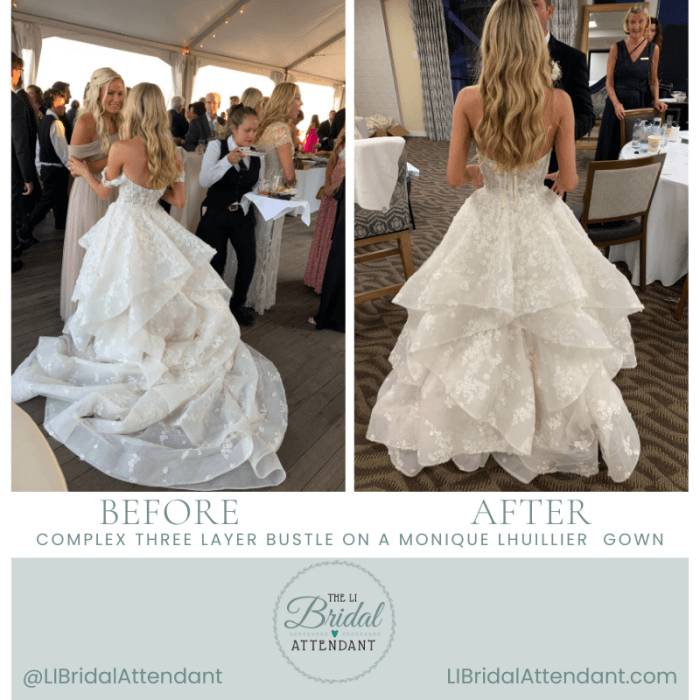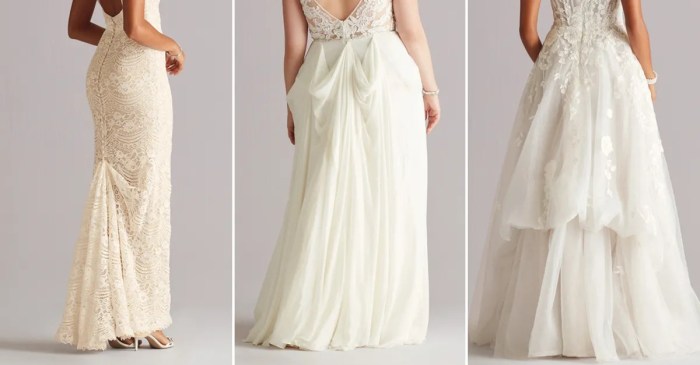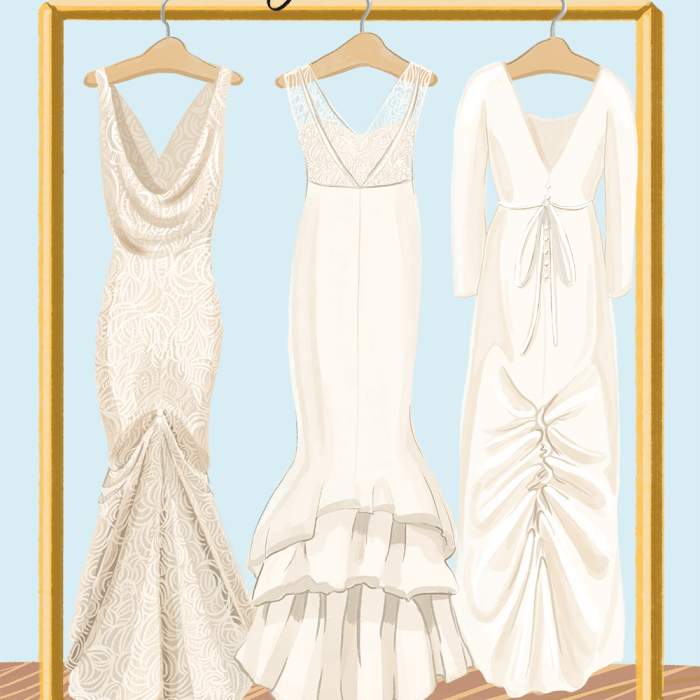Bustle Types and Attachment Methods
Bustle options for wedding dress – Choosing the right bustle for your wedding dress is crucial for achieving the desired silhouette and ensuring a comfortable and elegant look throughout your special day. This involves understanding the various bustle types, attachment methods, and how they interact with different dress styles and fabrics.
Types of Bustles
Several bustle styles cater to different dress designs and aesthetics. The choice depends on the dress’s silhouette, fabric, and the desired overall look. Consider these key differences:
| Bustle Type | Description | Visual Characteristics | Suitable Dress Styles |
|---|---|---|---|
| French Bustle | Creates a softly gathered look at the back of the dress, typically using multiple loops and bows. | Rounded, slightly poufed effect; train is gathered high and close to the body. | A-line, ballgown, princess-line gowns with moderate to heavy trains. |
| English Bustle | A more structured bustle, creating a fuller, more defined shape at the back. | Higher, more pronounced lift at the back; train is more dramatically gathered and raised. | Ballgowns, princess-line gowns with substantial trains. Not ideal for very lightweight fabrics. |
| Viennese Bustle | A combination of French and English styles, offering a balance of softness and structure. | Moderate lift and fullness; train is gathered but not as high as an English bustle. | A-line, ballgown, and mermaid styles; versatile option for various fabrics. |
| Overbustle | A separate, detachable piece that attaches to the back of the dress, offering a simple and versatile solution. | Can create a variety of looks depending on the style of the overbustle; usually adds fullness and lift. | Most dress styles; particularly useful for dresses with detachable trains. |
Heavier fabrics like satin or brocade often benefit from a more structured bustle like the English style, while lighter fabrics like chiffon or tulle might look better with a softer French bustle. The overall silhouette of the dress also plays a significant role; a mermaid-style dress might require a more tailored bustle to maintain its form.
Bustle Attachment Methods

Source: squarespace-cdn.com
Several methods exist for attaching a bustle, each offering different levels of ease of use, durability, and visual impact. The best method depends on the dress design and the skill level of the person attaching the bustle.
- Hooks and Eyes: Provides a secure and relatively invisible attachment. Suitable for most dress fabrics and bustle styles.
- Buttons: A classic and reliable method, offering good durability. Can be more visible than hooks and eyes.
- Ribbons: A more decorative method, often used in conjunction with other methods for added security. May not be as durable as hooks and eyes or buttons.
- Snaps: Offer quick and easy attachment, but may not be as strong as other methods. Best suited for lighter fabrics and less dramatic bustles.
- Sewing: Provides the most secure attachment, but requires more skill and time. Best for permanent bustles or delicate fabrics.
Attaching a bustle using hooks and eyes involves carefully positioning the hooks and eyes on the dress and bustle, ensuring a secure and even fit. Using ribbons requires threading the ribbons through designated loops or channels on the dress and bustle, tying them securely in a bow or knot. A step-by-step guide for each method would involve detailed diagrams and instructions beyond the scope of this text.
Bustle Considerations Based on Dress Style

Source: xogrp.com
The style of your wedding dress significantly influences the appropriate bustle choice. Consider these guidelines:
| Dress Style | Recommended Bustle Types | Considerations for Fabric | Examples of Suitable Bustles |
|---|---|---|---|
| A-line | French, Viennese | Lightweight to medium-weight fabrics work well. | A softly gathered French bustle complements the flowy nature of an A-line dress. |
| Ballgown | English, Viennese | Heavier fabrics may require a more structured bustle. | An English bustle provides a dramatic lift and fullness for a ballgown, enhancing its regal appearance. |
| Mermaid | Modified French, custom bustle | Fabric weight and structure are crucial for a flattering result. | A custom bustle may be needed to maintain the dress’s shape and prevent bunching. |
Delicate lace or heavily beaded fabrics might require careful consideration and potentially a more gentle attachment method to avoid damage. For example, a delicate lace ballgown might benefit from a French bustle attached with hooks and eyes to minimize stress on the fabric.
DIY vs. Professional Bustle, Bustle options for wedding dress
Creating a bustle yourself or having it professionally done presents distinct advantages and disadvantages.
A DIY bustle allows for greater cost savings and creative control. However, it demands sewing skills and accurate measurements. A professional bustle ensures a flawless fit and finish but incurs higher costs. Necessary tools for a DIY bustle include measuring tape, pins, needles, thread, hooks and eyes, and the bustle fabric itself.
A simple DIY bustle might involve creating loops of fabric and attaching them to the dress using hooks and eyes. Detailed instructions with diagrams are beyond the scope of this text.
Bustle Maintenance and Care
Proper care extends the life of your bustle. Regular inspections after each use are vital.
Inspect all attachments (hooks, eyes, buttons, ribbons) for looseness or damage. Clean any visible dirt or stains gently. Store the bustle in a breathable bag or garment bag to protect it from dust and moisture. A checklist could include: Inspect all attachments; Check for loose threads or fabric tears; Clean any visible dirt or stains; Store properly in a protective garment bag.
Visual Representations of Bustles

Source: brides.com
Choosing the right bustle for your wedding dress is crucial for both comfort and style. The options are varied, depending on the dress’s design and your personal preference. For instance, a simple bustle might be perfect for a streamlined silhouette, such as a boho sheath wedding dress , allowing for easy transition from ceremony to reception. Ultimately, the best bustle will enhance your dress and allow you to move freely throughout your special day.
Visualizing the different bustle styles is key to making an informed decision. A French bustle creates a soft, rounded shape at the back of the dress, subtly lifting the train. An English bustle produces a more dramatic, fuller shape with the train raised significantly higher. A Viennese bustle offers a balance between these two, providing a moderate lift and fullness.
FAQ Guide: Bustle Options For Wedding Dress
Can I bustle my dress myself?
While possible, DIY bustles require sewing skills and may not be as secure or aesthetically pleasing as a professional one. Consider your skill level before attempting it.
How much does professional bustling cost?
The cost varies greatly depending on the complexity of the bustle and the seamstress’s location and experience. Expect to pay anywhere from $50 to $300 or more.
Can I bustle a dress with a lot of beading or embellishments?
Yes, but extra care is needed to avoid damaging the delicate details. A professional is recommended for such intricate gowns.
How long does it take to attach a bustle?
This depends on the bustle type and attachment method. A simple bustle might take 15-30 minutes, while more complex ones could take longer.